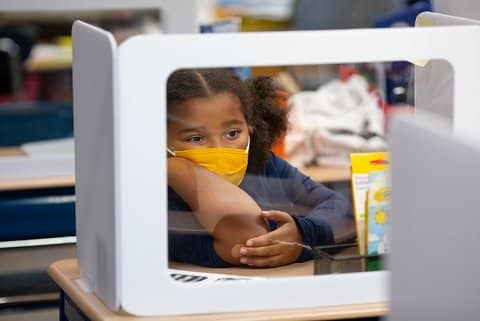
03 Jan Study Shows Lower Lifetime Earnings for Pandemic-Era Students

(“Second-grade girl in mask behind protection shield” by Allison Shelley for EDUimages via Alliance for Excellent Education on Flickr / CC BY-NC 2.0 license)
STANFORD (BCN) — Students nationwide face lower earnings over their lifetime because of a loss of education during the pandemic, a Stanford economist said in a recently completed study, adding that the loss will be even greater for California students.
The average student across the U.S. will lose $70,000 in earnings over their lifetime if something isn’t done to offset the learning loss.
California students may lose more than $70,000 in lifetime earnings because earnings overall are higher in California than in many other states.
>>>Read: Finally Back at School, Teens Have Mixed Emotions
Economist Eric Hanushek at Stanford’s Hoover Institution said to offset the loss “we need more effective teachers.”
Hanushek is an international expert in the economic analysis of educational issues.
He said the quality of learning is more important than the quantity of learning when it comes to offsetting the loss. Quality depends on the effectiveness of teachers, he said.
To improve learning quality, he said, schools can provide incentives to its best teachers.
“You provide incentives to your better teachers to take on more kids,” Hanushek said in an interview Dec. 29.
School systems now have a lot of federal money available to them and that money could be used to provide the incentives, Hanushek said. The money could also be used to buy out the contracts of the least effective teachers, he said.
Schools have tried to promote additional or longer school days to make up for learning losses. Hanushek said that may not be effective.
>>>Read: Distance Learning Presents Challenges for Students, Parents and Teachers
Hanushek estimated the loss in each state’s gross domestic product over the rest of the 21st century due to what may be a lower-skilled workforce.
GDP is expected to be about 1.4% lower each year in California over the rest of the century than it would be if the learning loss did not occur, according to the study. In dollar terms, the loss comes to $1.3 trillion through 2099.
Hanushek calculated that amount by adding up the losses each year and reducing the future ones. The future ones were reduced by an amount to account for their uncertainty and because losses in the future are not as painful as present ones.
California’s gross domestic product was about $3.37 trillion in 2021, according to the Federal Reserve Bank of St. Louis.
“These losses are permanent unless a state’s schools can get better than their pre-pandemic levels,” Hanushek wrote in the study.
>>>Read: Families Desperately Await Schools to Open
The immediate impact on California and other state’s economies will begin to be felt when current students finish school and become a substantial part of the labor force, the study said.
Because it will not be felt for years, people may ignore the impact.
“That is a mistake, because the economic impact is truly significant,” Hanushek wrote.
The study also said that disadvantaged children suffered greater losses in learning than other children and therefore may suffer greater losses in earnings.
Copyright © 2022 Bay City News, Inc. All rights reserved. Republication, rebroadcast or redistribution without the express written consent of Bay City News, Inc. is prohibited. Bay City News is a 24/7 news service covering the greater Bay Area.





No Comments